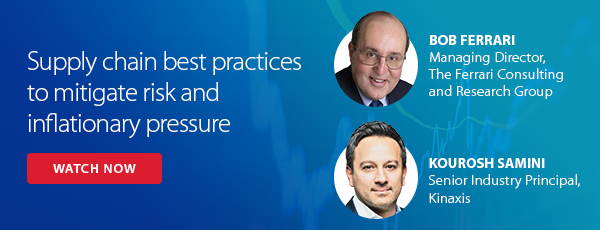By definition, the concept of risk involves uncertainty and brings with it the potential for negative consequences. As every supply chain planner knows, risk is a constant in global supply chains, and can take many different forms. Everything from sudden demand spikes and unexpected regulatory changes to geopolitical conflicts and natural disasters can create significant risks. And if these risks are not dealt with effectively, the fallout can be costly, including delays, shortages, lost revenue, and dissatisfied customers.
In a new on-demand webinar, Bob Ferrari, Managing Director of The Ferrari Consulting and Research Group, sits down for an in-depth discussion on supply chain risk with Kourosh Samini, Senior Industry Principal at Kinaxis and Jim Bralsford, Kinaxis Senior Director, Industry and Solutions Marketing. They discuss the nature of supply chain risk in the post-pandemic era and examine the mitigation strategies and best practices used by leading companies to ensure they’re equipped to thrive in this current period of economic uncertainty and inflationary pressure.
The evolving supply chain risk mitigation mindset
In his extensive work with supply chain professionals around the globe, Bob has seen a significant evolution over the last few years in the way companies approach risks to their supply chains. Before the pandemic made supply chains an everyday topic of conversation among consumers, companies tended to focus their attention on technical and operational supply chain risks. Time to delivery, customer fulfillment, supplier performance and other tactical issues were typically the biggest areas of concern for supply chain practitioners and the targets of their mitigation efforts.
While a tactical approach is still necessary, companies have begun to consider supply chain risks in another context: how they impact the overall performance of the business. Experiences and painful lessons learned during and after the pandemic were key contributing factors to this shift in mindset.
Bob cites the example of Reckitt Benckiser, which experienced a 20x demand spike over a two-quarter period for its Lysol products during the early months of the pandemic. The company relied on a manufacturing plant in Hubei province in China to produce these products. And while it was able to successfully ramp up production from 40 to 400 tons per day, extensive disruptions to global transportation meant that the company experienced severe challenges getting its products to market.
Being able to successfully address one issue (increased demand) didn’t help the company foresee its logistics problems following production. It’s become increasingly clear that considering overall impact of risks is now critical, which is an evolution from the traditional tactical-focused mindset.
Along with this evolution, Bob identifies two specific risks to supply chains that stand above all the others: climate-related risks and cyber security risks. The latter he considers to be the single biggest threat to supply chains going forward, not just from an IT perspective but in terms of the overall risk to the business.
Despite growing awareness of these and other risks among supply chain professionals and members of the C-suite, many organizations still lack effective risk mitigation strategies and tools.
Kourosh cites the recent worldwide chip shortage as a prime example of a disruption that has had far-reaching consequences across a wide variety of sectors. The automotive sector has been hit particularly hard hit by the shortage, and yet many leading companies in the industry are still struggling to mitigate its most damaging business impacts.
As Kourosh notes, “Many companies are still out there, still unable to respond quickly enough to the changing environment. Technically, it means they’re always behind the problem, instead of being ahead of the problem.”
Best practices for risk mitigation
Fortunately, there are proven best practices that supply chain professionals can adopt to help them anticipate risks, assess their exposure to each and take specific actions to mitigate them. In the webinar, the panelists talk about key best practices they’re seeing in the market, such as the importance of running risk-mitigating scenarios at all levels of the supply chain, taking into account all the relevant variables, including potential constraints, financial impacts, and customer promises.
Bob also points to the growing trend among companies in every sector of getting their executives more involved in strategic supply chain issues to help them better understand how these issues may impact key business metrics such as customer service levels, product margins, and profitability.
When companies get risk mitigation right, the benefits are clear, especially as they face inflationary pressure and the prospect of a recession. The right approach means you can make quick, data-driven decisions to minimize the impact of various types of risks, while also driving better performance against the competition.
Watch the on-demand webinar now to get the full story, along with exclusive insights including:
- How to define what risk means for the supply chain practitioner, the C-suite and Board
- When they get it right, what results are successful companies achieving?
- Is risk all about financial performance?
For more on how to manage supply chain disruption no matter what happens, click here.






